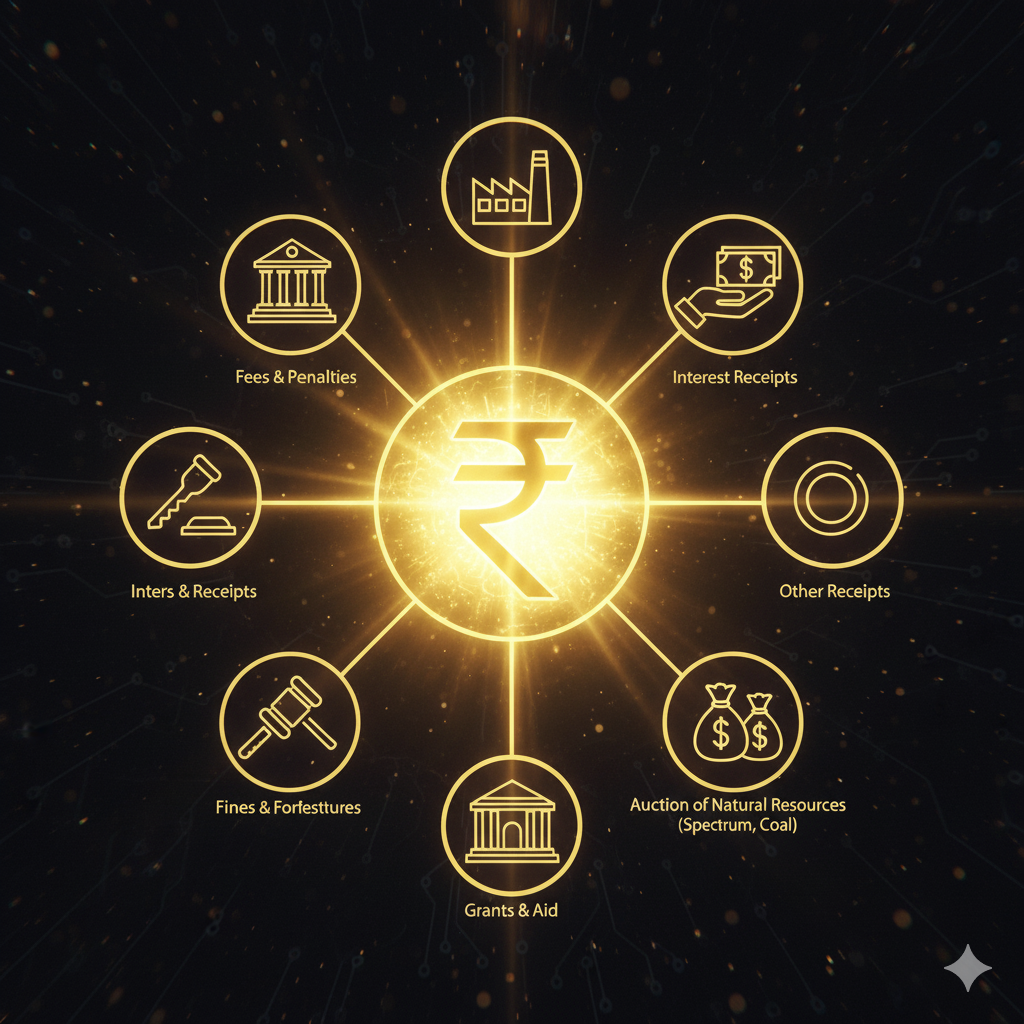Introduction
Revenue generation is a critical function of any government. To finance its expenditures—such as infrastructure development, social welfare schemes, defense, and administrative operations—the government relies on two broad sources of income: tax revenue and non-tax revenue.
While tax revenue is collected through compulsory levies on individuals and businesses, non-tax revenue refers to income earned by the government without imposing a tax. It is an essential component of the fiscal framework, helping governments diversify their revenue sources, reduce dependence on taxes, and manage fiscal deficits.
Non-tax revenue is often overlooked in public discourse compared to taxes, but it plays a strategic role in India’s economy, contributing to funding public goods, supporting development projects, and ensuring financial stability.
This article explores the concept, sources, classification, objectives, advantages, and challenges of non-tax revenue in India.
1. Meaning of Non-Tax Revenue
Non-tax revenue refers to all receipts of the government other than taxes and duties. Unlike tax revenue, which is compulsory and statutory, non-tax revenue arises from government-owned assets, services, fees, fines, and returns on investments.
Key Features of Non-Tax Revenue
- Non-Compulsory Nature – It is generally earned from voluntary transactions or returns on assets.
- Non-Repayable – Unlike loans, non-tax revenue does not create a liability for repayment.
- Diversified Sources – Includes fees, fines, profits, dividends, and grants.
- Supplementary to Tax Revenue – Helps reduce the government’s reliance on taxes.
Example:
- Dividends from public sector undertakings (PSUs)
- Interest from loans given to state governments or institutions
- Fees for issuing passports or licenses
2. Classification of Non-Tax Revenue
Non-tax revenue can be broadly classified into five main categories:
A. Fees and User Charges
These are payments made by individuals or businesses in exchange for services provided by the government.
- Examples:
- Fees for issuing passports, driving licenses, and birth certificates
- Tuition fees in government-run educational institutions
- Charges for water supply, electricity in government offices
B. Fines and Penalties
Revenue collected from violations of laws, regulations, or administrative orders.
- Examples:
- Traffic fines and penalties for environmental violations
- Penalties for delayed tax payment or customs violations
- Court-imposed fines under various statutes
C. Profits and Dividends
Income earned from government-owned enterprises and corporations, often referred to as Public Sector Undertakings (PSUs).
- Examples:
- Dividends from entities like ONGC, Indian Oil, and Coal India
- Profits from state-owned banks and financial institutions
D. Interest Receipts
Revenue earned by the government from loans and advances granted to other entities.
- Examples:
- Loans to state governments, PSUs, or cooperative societies
- Advances to foreign governments or international organizations
E. Grants and Aid
This includes monetary assistance from foreign governments, international institutions, or voluntary donations, often tied to specific projects.
- Examples:
- Grants from the World Bank or IMF for development projects
- Assistance for disaster relief and humanitarian aid
3. Sources of Non-Tax Revenue in India
India’s non-tax revenue comes from multiple sources, broadly categorized as follows:
1. Administrative Receipts
Revenue collected as fees, fines, and penalties from the general public in exchange for government services.
- Passport fees, driving licenses, legal registration fees
- Environmental fines and penalties for legal violations
2. Economic Receipts
Income generated from government-owned economic activities and assets.
- Dividends and profits from PSUs
- Profits from the Reserve Bank of India (RBI) operations
- Royalties from natural resources like coal, oil, minerals
3. Grants-in-Aid and Contributions
Funds received from international organizations, foreign governments, or state governments.
- Grants for education, healthcare, and infrastructure projects
- Disaster relief assistance
4. Miscellaneous Receipts
Other forms of non-tax revenue include:
- Sale of government assets, land, or property
- Auction of licenses (e.g., spectrum allocation for telecom)
- Earnings from lotteries and gambling regulation
4. Objectives of Non-Tax Revenue
The main objectives behind generating non-tax revenue include:
- Supplementing Tax Revenue – Helps the government fund public expenditures without increasing tax burden.
- Resource Mobilization – Utilizes government assets efficiently to generate income.
- Promoting Accountability – Fee-based services ensure that government services are used efficiently.
- Encouraging Investment in Public Sector – Profits and dividends from PSUs encourage efficient operations.
- Supporting Welfare Programs – Grants and aid provide funds for health, education, and disaster relief.
- Reducing Fiscal Deficit – Non-tax revenue contributes to bridging the gap between revenue and expenditure.
5. Importance of Non-Tax Revenue in India
Non-tax revenue is crucial for India’s fiscal and economic management. Its importance can be highlighted as follows:
- Revenue Diversification – Reduces dependence on taxes, especially income and corporate taxes.
- Funding Public Services – Provides resources for public goods like education, healthcare, and infrastructure.
- Promoting Efficiency – Charges for services promote responsible usage and reduce wastage.
- Supporting Economic Development – Income from PSUs and royalties finances industrial and social development.
- Enhancing Fiscal Stability – Regular non-tax receipts help stabilize government finances.
- Facilitates Investment in PSUs – Encourages profit-oriented functioning of public enterprises.
6. Trends in Non-Tax Revenue in India
Historically, India’s non-tax revenue has shown gradual growth, though it remains lower than tax revenue. Some key trends include:
- PSU Dividends – Significant contribution from oil and energy companies.
- Royalties and Resource Exploitation – Increasing revenue from mining, forestry, and natural resources.
- Service Fees – Expansion of government services, e-governance, and licenses increased administrative receipts.
- Interest Receipts – Loans to states and other organizations contribute a stable source of revenue.
Despite growth, non-tax revenue is often volatile, depending on PSUs’ profitability, resource prices, and grant allocations.
7. Advantages of Non-Tax Revenue
- Non-Burdensome – Does not directly burden taxpayers like taxes.
- Encourages Efficient Use of Government Assets – Revenue from PSUs and natural resources incentivizes productivity.
- Supports Welfare Schemes – Grants and aid help finance social and development programs.
- Promotes Accountability – Fee-for-service mechanisms ensure efficient utilization.
- Stabilizes Fiscal Position – Provides additional funds for government expenditure.
- Reduces Deficit Financing – Less dependence on borrowing from markets.
8. Challenges in Non-Tax Revenue Collection
Despite its advantages, non-tax revenue in India faces several challenges:
- Dependence on PSUs – Revenue is affected by PSU profitability, which can be volatile.
- Resource Price Fluctuations – Royalties and natural resource earnings fluctuate with global commodity prices.
- Administrative Inefficiency – Poor implementation of user charges and fees reduces potential revenue.
- Underutilization of Assets – Idle government assets lead to loss of potential income.
- Delayed Grants and Aid – Reliance on foreign assistance can be unpredictable.
- Limited Awareness – Citizens may be unaware of available services or fees, reducing receipts.
9. Measures to Improve Non-Tax Revenue
To increase efficiency and maximize non-tax revenue, India can adopt several measures:
- Better Management of PSUs – Strengthening profitability and dividend policies.
- Efficient Use of Government Assets – Leasing, commercialization, or privatization of idle assets.
- E-Governance for Service Fees – Online payment systems for licenses, certificates, and services.
- Rationalization of Royalties and Charges – Ensuring resource extraction contributes fair revenue.
- Encouraging Public-Private Partnerships (PPP) – Joint ventures to generate revenue.
- Transparency and Accountability – Proper auditing of non-tax revenue sources to avoid leakage.
10. Non-Tax Revenue vs Tax Revenue
| Feature | Tax Revenue | Non-Tax Revenue |
|---|---|---|
| Compulsory | Yes | No |
| Source | Taxes on income, goods, and services | Fees, fines, dividends, interest, grants |
| Purpose | Revenue mobilization for government spending | Supplementary, efficiency, and resource utilization |
| Predictability | More stable | Can be volatile |
| Equity | Progressive or proportional | May favor users of specific services |
| Examples | Income tax, GST, corporate tax | PSUs dividends, passport fees, royalties |
11. Conclusion
Non-tax revenue plays a vital role in India’s fiscal framework, complementing tax revenue, stabilizing finances, and supporting social and economic development. Its sources—fees, fines, dividends, interest, and grants—reflect the diverse economic activities of the government.
While tax revenue forms the backbone of government income, non-tax revenue provides flexibility, efficiency, and additional resources for development projects. With better asset management, e-governance, and strategic policy measures, India can enhance non-tax revenue, reduce fiscal deficits, and promote sustainable economic growth.
Non-tax revenue, though sometimes overlooked, is a key instrument for public finance management, making it an essential topic for students of economics, public administration, and competitive exams.




